skip to main |
skip to sidebar
I may have mentioned once or twice or a few dozen times that, or the first 30 or so years of my life, I hated parakkai (also known as pavakkai, karela, bittermelon or bittergourd - or, if you're my husband, as "green rats"). If you're a karela lover, today's recipe will be right up your street. If you're not a karela lover, this recipe will still be quite a way up your street because you will not taste the bitterness from the vegetable at all.
If you know your karela at all, you would think it's hard to mask the bitterness, but because everything is roasted and there are lots of other ingredients, the resultant powder has no discernible bitterness. At least, none that I could taste. And I didn't even peel the skin or discard the seeds (although if they're red and hard, DO scoop them out and discard) or salt the cut bittergourd to reduce the bitterness. Because I'm lazy and that's the way I roll, baby.
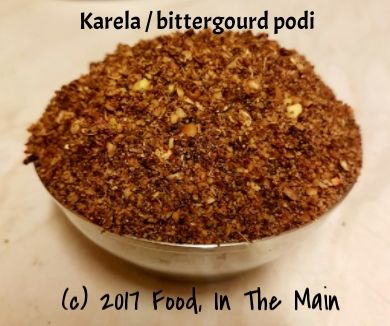
I ate this mixed with rice and ghee, I ate it sprinkled over roasted vegetables, I ate it as a side with kootu and roti, I ate it mixed with yogurt both as a dip and as a salad dressing - it's my most favourite thing at the moment, and it seems to work with everything.
Best of all, since the karela is oven roasted with only a mimimal amount of oil, it's a healthy podi. There are versions where the vegetable is deep fried until crisp, but - while I love deep fried foods with a deep and abiding love - I see no need to load this podi with unnecessary calories.
Recipe for: Bittergourd / pavakkai / karela podi
Ingredients:

3-4 medium size tender karela
10 dried red Kashmiri chillies
2 tbsp coriander seeds
2 tbsp whole urad dal
2 tbsp chana dal
2 tbsp kollu or horsegram
2 tbsp fresh or frozen grated unsweetened coconut
1 tbsp black sesame seeds (regular will probably also do)
Handful of curry leaves (fresh or frozen)
2-3 cloves of garlic, halved
1 small gooseberry sized ball of tamarind (seeds and strings removed if any)
1/2 tsp asafoetida powder
1/2 tsp + 1 tbsp oil
Salt to taste (or about 1.5 tsp)
Method:
1. Thinly slice the karela, mix with 1 tbsp oil and roast in a 180C/350F oven until the slices are brown with very little green showing. This should take about 30 minutes, but be sure to stir them around every 10 minutes so that they crisp evenly. Let them cool completely.
2. Heat the oil in a wok and add the red chillies. Roast on a medium-low flame, stirring often until the chillies turn a darker shade, about 5 minutes. Be careful not to burn them or you'll regret the fumes! Remove to a plate and cool.
3. Add the coriander seeds, the sesame seeds and all the dals. Dry roast them, stirring often, until they are toasted and fragrant, and turn a darker shade. Again, don't burn them or the podi will taste bitter. Add to the roasted chillies and let cool.
4. Finally, add the coconut, curry leaves, garlic and tamarind and toast in the pan, stirring frequently, until the coconut has turned golden brown and has no more moisture in it - yet again, be careful not to burn it.
5. Once all the ingredients are cool, grind them into a slightly coarse powder. Add salt and asafoetida powder and mix well. Store in an airtight container.
I can't seem to get enough of karela or bittergourd nowadays - I really love these ugly knobbly vegetables that look like a bit like rats with a long tail. A couple of days back, I went to my favourite "Indian" shop in Wellington for vegetables, and was beyond thrilled to find small baby karela for sale. I picked out the freshest 10 and came home joyfully, having decided how I was going to cook them. Stuffed, basically. I didn't want the stuffing to be the usual onion masala or potato masala or peanut-based masala - mainly because I didn't want to spend time cooking the stuffing. Bad enough that I would have to wait for the karela itself to cook.
So I just put together a random mixture of flours and spices, toasted the mix in a dry pan until fragrant, then used some oil and water to bind the powdery mix and make it amenable to stuffing, basically.
I admit that this recipe uses more oil than usual, but it's worth it if you love karela and only make it once in a while. It was SO delicious. I had the stuffed karela with lemon masoor dal and rice and a little ghee, and felt like I had gone to heaven without having to die first. Yes, THAT good.
So good that I forgot to take a photo before diving into the karela. Oops...
Recipe for: Stuffed karela
Ingredients:
6-8 small (about 4-5 inches length) tender karela
For the masala paste
1/4 cup soya flour or jowar flour
1/2 cup chickpea flour (besan/kadalai maavu)
1/8 cup rice flour
4 tbsp coriander powder
1 tsp cumin powder
1/2 tsp aniseed powder
1/2 tsp fennel powder
1 tsp garam masala/rasam powder/any other masala you prefer
2 tsp red chilli powder (or to taste)
1/4 tsp asafoetida powder
Salt to taste
4 tbsp oil
Method:
1. Lightly peel the karela so that the ridges no longer stick out. Make a slit in each karela from end to end, being careful not to cut right through to the other side.
2. Use the handle of a small spoon to gouge out the inner seeds and membrane.
3. At this point you can rub salt on the inside and outside of the karela and let it sit for a few hours so that some of the bitter juices are drawn out. If you do this, be sure to squeeze the juices out, then wash the karela well to remove the excess salt. Pat dry with kitchen paper and reserve.
4. Mix together all the ingredients for the masala paste, bar the oil. Heat a pan and dry toast the mixed masala powder, stirring constantly, until the flours start to smell fragrant and savoury. Be careful not to burn it.
5. Once the masala mix is toasted, transfer it to a container. This might be more than you require, but you can always store the excess for another day in an airtight container. I prefer to make extra, because I don't like it when I find out halfway through stuffing that there isn't enough masala paste to fill all the karela. so you can use all of the toasted mix, or just half, depending on how many karela you have and their size.
6. Now add 2 tbsp of the oil to the masala powder and stir it in. The paste needs to come together enough that if you pinch some together, it shouldn't fall apart. You can add a bit more oil to get the powder to that stage, or you can add a little water. Either way, don't make it into a gooey paste.
7. Once the masala mix is ready, use your fingers to stuff it into the karela. Once they are all stuffed, you can use kitchen string to tie the karela so the stuffing doesn't come out (it tends to expand a bit as it cooks), but it's not strictly necessary especially if the karela is small.
8. Heat the remaining 2 tbsp oil in a pan and add 1/4 tsp asafoetida to it. As soon as it sizzles, put the stuffed karela in the pan and stir them gently so they are coated in the oil. Sprinkle 2-3 tbsp water over the karela and close the pan. Cook the karela covered over medium-low heat for 15 minutes or until they soften and turn a paler green. After that take the lid off and turn up the heat a bit more, occasionally turning them over, until they turn brown and crisp on all sides.
Serve hot with dal and rice.
Over the last few years, I’ve been testing my limits with that most unattractive of vegetables, the bittergourd (or karela, bitter melon, pavakkai or whatever name you call it – my husband terms them “rats”), to see just HOW much I love it.
I used to hate it completely, in any form, as a kid. In my late teens or thereabouts, I would as a concession eat them deep fried (yes, I know, very broad-minded of me) mainly because the ones from Hot Chips in Abhiramapuram were sensational.
Eventually, after a couple of decades, I got around to eating them pan-fried crisp, as a dry curry. After that things moved a lot more rapidly in the experimentation department, and I moved on to karela-without-frying-too-much, karela as a semi-dry curry cooked with onions and tomatoes, karela with mustard paste (a double-whammy in the strong flavour department).
While karela pitla (South Indian style) is probably not as scary as it used to be, or even as full-on as karela-with-mustard-paste, I still had to see if I'd like it - just to drive away the last of the childhood fear and hatred of the karela's bitter flavour. And, of course, I passed the test with flying colours, practically inhaling the pitla which my mother made a day or two before she left Shrewsbury.
The only karela-based item that I know I won't like is karela juice. Where that is concerned, I think I'm as blinkered as I ever was, with just one standard reaction: "No way Felipe." (Jose wasn't available.)
Recipe for: Bittergourd/karela/pavakkai pitla
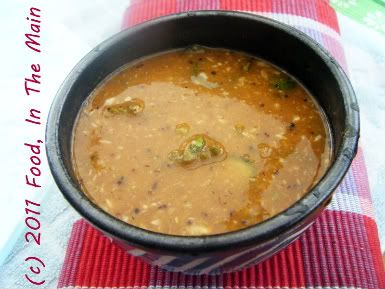
Ingredients:
2 medium karela/bittergourd/pavakkai, sliced into rounds
1 cup masoor dal, cooked
1 tbsp tamarind paste
3 tsp gingelly oil (or any neutral cooking oil)
1 tsp mustard seeds
2 tbsp sambar powder
2 tbsp finely grated coconut
1/2 tsp asafoetida powder
1 tbsp rice flour
Salt to taste
a few fresh curry leaves, torn up
3-4 cups water
Method:
1. Heat the oil in a small pan and add the asafoetida powder, mustard seeds and curry leaves.
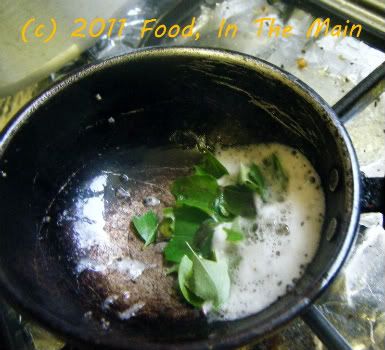 Cover and let the seeds pop, then add the grated coconut.
Cover and let the seeds pop, then add the grated coconut.  Fry on medium heat till the coconut is light brown and aromatic.
Fry on medium heat till the coconut is light brown and aromatic. 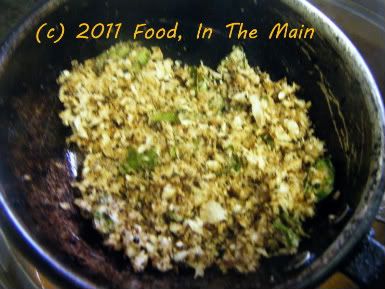 Remove from heat and set aside till required.
2. Put about a cupful of water in a pan along with the karela/bittergourd/pavakkai and turmeric powder.
Remove from heat and set aside till required.
2. Put about a cupful of water in a pan along with the karela/bittergourd/pavakkai and turmeric powder. 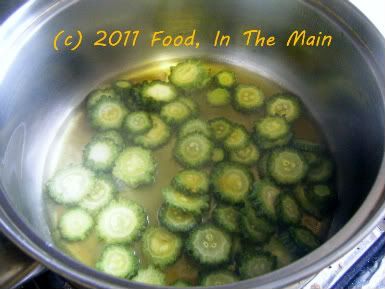 Let it cook till it becomes soft.
3. Dissolve the tamarind paste in 2 cup water and add it to the cooked karela/bittergourd/pavakkai.
Let it cook till it becomes soft.
3. Dissolve the tamarind paste in 2 cup water and add it to the cooked karela/bittergourd/pavakkai.
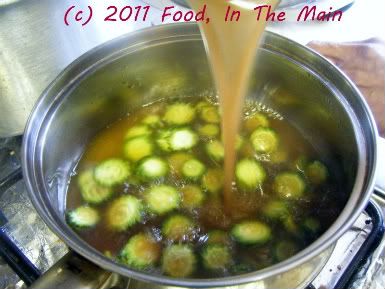 4. Bring this to a boil, then add the sambar powder and rice powder and stir till well mixed.
4. Bring this to a boil, then add the sambar powder and rice powder and stir till well mixed.
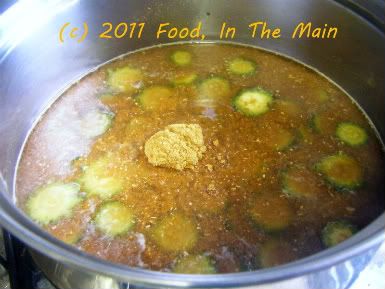 5. Stir in the cooked masoor dal
5. Stir in the cooked masoor dal 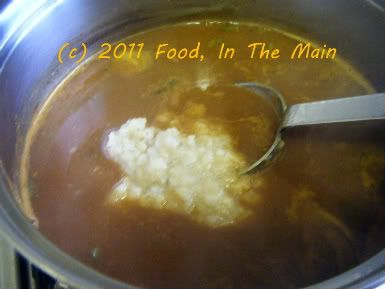 6. Add salt to taste along with the roasted coconut and mix in.
6. Add salt to taste along with the roasted coconut and mix in. 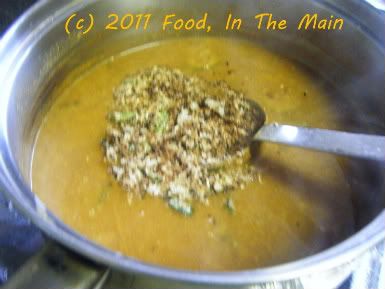 7. Boil the pitla for a few minutes longer till it thickens.
7. Boil the pitla for a few minutes longer till it thickens. 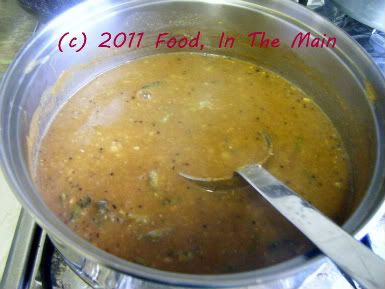 Serve hot with rice.
Serve hot with rice. 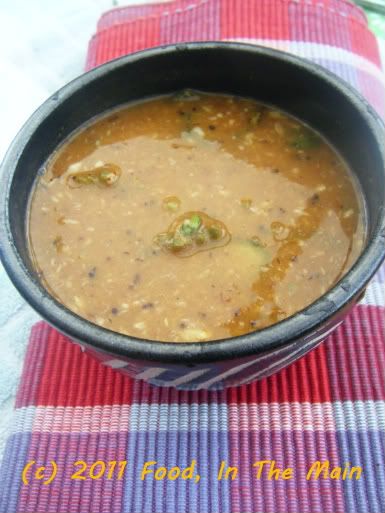 RECIPE: BITTERGOURD/KARELA/PAVAKKAI PITLA
Ingredients:
2 medium karela/bittergourd/pavakkai, sliced into rounds
1 tbsp tamarind paste
3 tsp gingelly oil (or any neutral cooking oil)
1 tsp mustard seeds
2 tbsp sambar powder
2 tbsp finely grated coconut
1/2 tsp asafoetida powder
1 tbsp rice flour
Salt to taste
a few fresh curry leaves, torn up
3-4 cups water
Method:
1. Heat the oil in a small pan and add the asafoetida powder, mustard seeds and curry leaves. Cover and let the seeds pop, then add the grated coconut. Fry on medium heat till the coconut is light brown and aromatic. Remove from heat and set aside till required.
2. Put about a cupful of water in a pan along with the karela/bittergourd/pavakkai and turmeric powder. Let it cook till it becomes soft.
3. Dissolve the tamarind paste in 2 cup water and add it to the cooked karela/bittergourd/pavakkai.
4. Bring this to a boil, then add the sambar powder and rice powder and stir till well mixed.
5. Stir in the cooked masoor dal.
6. Add salt to taste along with the roasted coconut and mix in.
7. Boil the pitla for a couple of minutes longer. Serve hot with rice.
RECIPE: BITTERGOURD/KARELA/PAVAKKAI PITLA
Ingredients:
2 medium karela/bittergourd/pavakkai, sliced into rounds
1 tbsp tamarind paste
3 tsp gingelly oil (or any neutral cooking oil)
1 tsp mustard seeds
2 tbsp sambar powder
2 tbsp finely grated coconut
1/2 tsp asafoetida powder
1 tbsp rice flour
Salt to taste
a few fresh curry leaves, torn up
3-4 cups water
Method:
1. Heat the oil in a small pan and add the asafoetida powder, mustard seeds and curry leaves. Cover and let the seeds pop, then add the grated coconut. Fry on medium heat till the coconut is light brown and aromatic. Remove from heat and set aside till required.
2. Put about a cupful of water in a pan along with the karela/bittergourd/pavakkai and turmeric powder. Let it cook till it becomes soft.
3. Dissolve the tamarind paste in 2 cup water and add it to the cooked karela/bittergourd/pavakkai.
4. Bring this to a boil, then add the sambar powder and rice powder and stir till well mixed.
5. Stir in the cooked masoor dal.
6. Add salt to taste along with the roasted coconut and mix in.
7. Boil the pitla for a couple of minutes longer. Serve hot with rice.
I suppose I should be embarrassed about even considering this a recipe - and I suppose I am, a bit. But if I didn't write about it, there wouldn't be a post. There needs to be a post, and many more posts, if I am to reach my target of 500 posts. Not 500 posts this year (I wish!), but 500 posts in total since I started this blog. Looked at it that way, my output isn't particularly noteworthy, really. But it's all I have.
Anyway, I wish I could remember which blog it was where a commenter had mentioned that she always mixed raw karela with some yogurt and microwaved it for 3 minutes before going on to cook the vegetable on the hob.. and this way the karela was NEVER bitter.
I thought I’d try that out too, but I’m not sure how much it helped, if it did at all. Maybe it reduced the bitterness a little - but then I don’t have a huge problem with the bitterness of the vegetable when it’s shallow fried, especially as a side dish with rice. In any case, unless you try it cooked with yogurt and without, and compare the two side-by-side, it’s pretty hard to quantify any reduction in the level of bitterness in any useful way. Next time, maybe.
The karela rice only happened because I forgot to make sambar or any other kuzhambu, and I didn’t have any paruppu podi or thogayal ready – and only realized this when I got hungry for my dinner.
No problem – I mixed the karela dry-fry with the rice and called it “karela rice” and had that with yogurt, thereby getting around the problem of the missing sambar. Inspired innovation? Or merely good spin put on a pathetic situation? You decide.
Recipe for: Karela rice
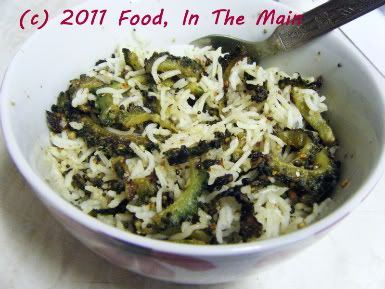 Ingredients:
1 cup basmati rice, cooked and cooled
2 medium karela (bitter melon/gourd)
2 tbsp yogurt/curd
1 tsp mustard seeds
5-6 fresh curry leaves
2 tbsp oil
Salt to taste
3 tbsp vegetable spice mix
Method:
1. Halve the karela lengthwise, then slice it into thin half-moons.
Ingredients:
1 cup basmati rice, cooked and cooled
2 medium karela (bitter melon/gourd)
2 tbsp yogurt/curd
1 tsp mustard seeds
5-6 fresh curry leaves
2 tbsp oil
Salt to taste
3 tbsp vegetable spice mix
Method:
1. Halve the karela lengthwise, then slice it into thin half-moons.
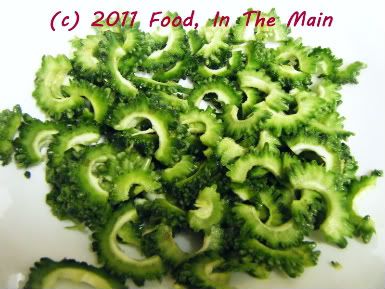 2. Toss the pieces with the yogurt/curd until they are evenly coated. Microwave, covered, for 3 minutes. Reserve.
2. Toss the pieces with the yogurt/curd until they are evenly coated. Microwave, covered, for 3 minutes. Reserve.
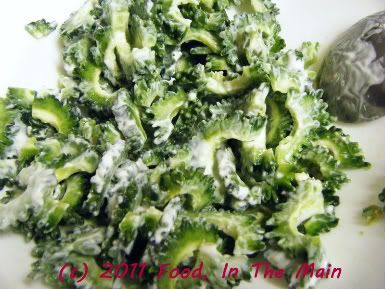 3. Heat the oil in a pan and add the curry leaves and mustard seeds. Let the seeds pop on meium-high heat, then add the karela pieces and stir well.
3. Heat the oil in a pan and add the curry leaves and mustard seeds. Let the seeds pop on meium-high heat, then add the karela pieces and stir well.
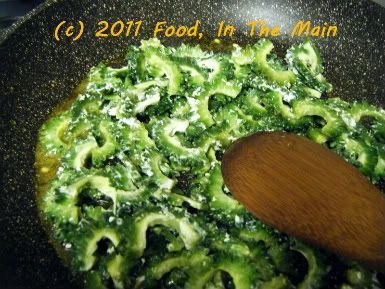 4. Let the karela cook on low heat for 8-10 minutes, till they are soft and cooked. Then turn the heat up to medium so that they can become a little crisp and brown. Add salt to taste and mix in.
5. Now add the 3 tbsp vegetable spice mix and stir well.
4. Let the karela cook on low heat for 8-10 minutes, till they are soft and cooked. Then turn the heat up to medium so that they can become a little crisp and brown. Add salt to taste and mix in.
5. Now add the 3 tbsp vegetable spice mix and stir well.
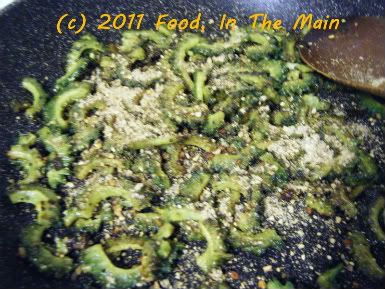 6. Now mix in the rice gently with the karela, so as not to break the grains. Turn the heat down to low and let the rice heat up thoroughly. Serve hot with raita and papad or potato chips.
RECIPE: KARELA RICE
Ingredients:
1 cup basmati rice, cooked and cooled
2 medium karela (bitter melon/gourd)
2 tbsp yogurt/curd
1 tsp mustard seeds
5-6 fresh curry leaves
2 tbsp oil
Salt to taste
3 tbsp vegetable spice mix
Method:
1. Halve the karela lengthwise, then slice it into thin half-moons.
2. Toss the pieces with the yogurt/curd until they are evenly coated. Microwave, covered, for 3 minutes. Reserve.
3. Heat the oil in a pan and add the curry leaves and mustard seeds. Let the seeds pop on meium-high heat, then add the karela pieces and stir well.
4. Let the karela cook on low heat for 8-10 minutes, till they are soft and cooked. Then turn the heat up to medium so that they can become a little crisp and brown. Add salt to taste and mix in.
5. Now add the rice to the karela along with 3 tbsp of the vegetable spice mix. Mix it in gently so as not to break the rice grains.
6. Turn the heat down to low and let the rice heat up thoroughly. Serve hot with raita and papad or potato chips.
6. Now mix in the rice gently with the karela, so as not to break the grains. Turn the heat down to low and let the rice heat up thoroughly. Serve hot with raita and papad or potato chips.
RECIPE: KARELA RICE
Ingredients:
1 cup basmati rice, cooked and cooled
2 medium karela (bitter melon/gourd)
2 tbsp yogurt/curd
1 tsp mustard seeds
5-6 fresh curry leaves
2 tbsp oil
Salt to taste
3 tbsp vegetable spice mix
Method:
1. Halve the karela lengthwise, then slice it into thin half-moons.
2. Toss the pieces with the yogurt/curd until they are evenly coated. Microwave, covered, for 3 minutes. Reserve.
3. Heat the oil in a pan and add the curry leaves and mustard seeds. Let the seeds pop on meium-high heat, then add the karela pieces and stir well.
4. Let the karela cook on low heat for 8-10 minutes, till they are soft and cooked. Then turn the heat up to medium so that they can become a little crisp and brown. Add salt to taste and mix in.
5. Now add the rice to the karela along with 3 tbsp of the vegetable spice mix. Mix it in gently so as not to break the rice grains.
6. Turn the heat down to low and let the rice heat up thoroughly. Serve hot with raita and papad or potato chips.
This is the karela recipe I was being so mysterious about, about a month ago or so. Those of you who do NOT remember what I was being mysterious about, please click on the link for a memory refresh. (Oh, the things I do for the convenience of my readers...! Might I have made a new follower, perhaps, or even two, by being thoughtful and ironic? One does so hope so.)
So yes, this is yet another karela recipe - and what’s more, I have another one up my sleeve (a post, not a karela), although that is not as radical as this one. This, though... this is THE most radical recipe I’ve ever made featuring this bitter vegetable, and I have to say that it really tested my karela-love. I would definitely consider this to be the penultimate conclusive test of karela-love, no question. The ultimate conclusive test, of course, being the willing consumption of fresh-squeezed karela juice. (You’d have to strap me down for that one, I reckon, and force-feed me it through a tube.)
This is an Oriya recipe, which I got from here and I consider myself very brave to have used Indian karela, which is way more bitter than the Chinese karela used in the original. Okay, the truth is that I would probably have used Chinese karela too, if only I’d had it handy. But I didn’t. Chinese karela is much less knobblier on the outside and much less bitter on the inside than the Indian variety.
Anyway, the reason I tried this recipe is because it uses mustard paste – and I love the sharp tangy taste of mustard paste and mustard oil. It’s a fairly recently discovered love, just short of a year old, actually.
Perhaps the end result would have been less bitter if I’d done the salting-waiting-squeezing routine that removes some of the bitterness from this vegetable, but I didn’t. Call it foolhardiness. However, I still liked the end result – I know, I know, shocking! The mustardiness was as yummy and nose-clearingly sharp as ever, underlaid by the bitterness of the karela. I just couldn’t eat the mustardy karela on its own, though. It needed toning down with cold curd rice... which turned out to be the perfect combination, in the end.
(Total "karela" usage count in one post: 13, including this one. Do I get an award?)
Recipe for: Mustardy karela
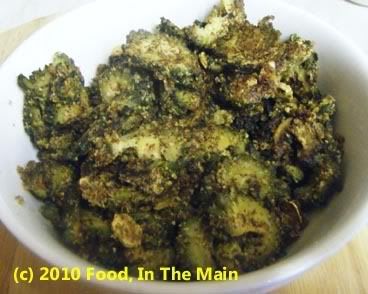
Ingredients:
2 cups bittergourd, sliced into rounds
Oil for pan frying (about 3-4 tbsp)
2 tbsp rice flour
1/2 tsp turmeric powder
salt to taste
3 tbsp mustard seeds
3-4 fresh green chillies (or to taste)
3 cloves garlic
Method:
1. Dry grind the mustard seeds and then add chillies, garlic and water.
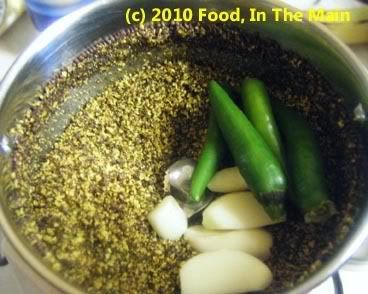
Make a thick paste with a little water so that it can coat the bitter gourd completely.
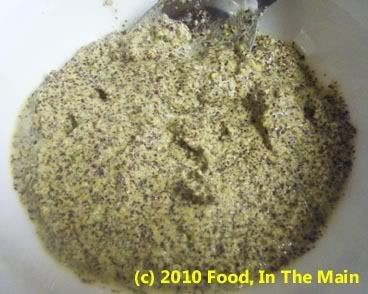
2. Steam-cook the sliced bittergourd with a few tbsp water
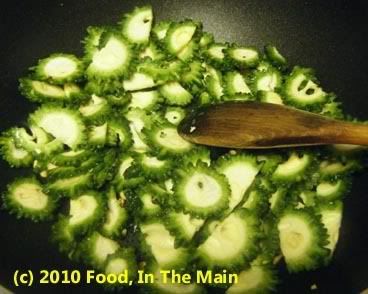
till done, but not mushy.
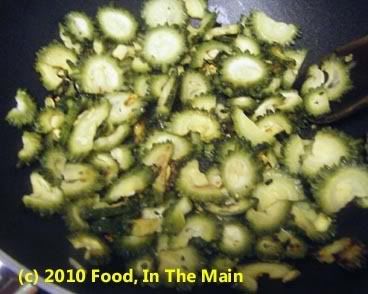
3. Mix the mustard paste with the cooked bitter gourd.
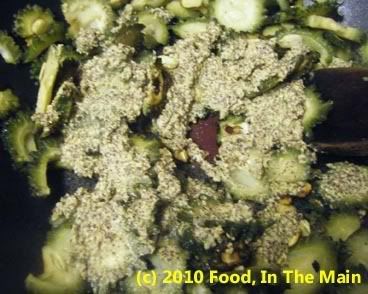
4. Then add the turmeric, rice flour and salt to taste.
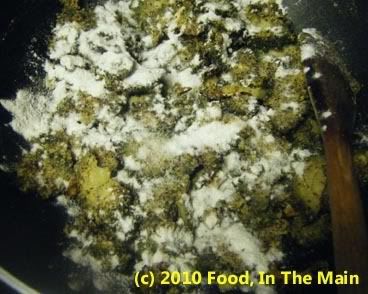
Mix in till evenly distributed.
5. Heat 3-4 tbsp oil in a shallow frying pan. Add the bitter gourd, spread them out gently,
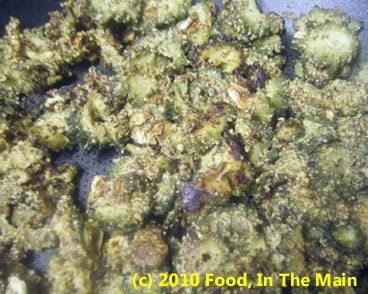
and fry the pieces on both sides till crisp and well done.
6. Serve as a side dish with rice and dal.
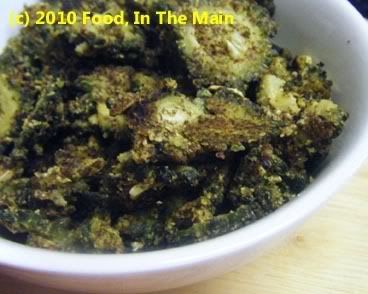
I find I'm a bit worried about getting more and more radical with my bitter melon/bitter gourd/karela/pavakkai recipes, in that I’m using this vegetable in a less and less disguised fashion, as it were. I won't hide the fact that I'm feeling kind of - wait for it – meloncholy, the sort that leaves a.... yes, a somewhat bitter taste behind...
Time was when the only way I would even look at this knobbly-looking vegetable was if it was coated in seasoned gram flour and deep fried. And even then it wasn’t exactly welcome on my plate (or on my palate, heh. Tell me you love these punny asides, because I won’t accept a negative answer. What, did you think this was a democratic blog? Tut).
First I made my own karela chips. Then this. And this. And now, karela masala rice! Where oh where will it all end???
Be warned, readers, this recipe is only for those who love this vegetable. (Although, all evidence to the contrary, I still maintain that I’m not a member of the aforementioned karela-loving group. I mean yeah, I eat it. But would I reach for karela over, say, potatoes? Or green beans? Or plantains? No way, no how.) I used brown basmati instead of white rice, and cooked it with a bit of turmeric powder as per Suganya’s advice on her blog, Tasty Palettes – note that the idea for this recipe, and part of the method, is derived from her own post. I added peanuts for crunch (and some relief from the bitterness) and had a cool cucumber raita on the side, which is also, I think, essential to balance the taste.
Remember that rhetorical question I asked earlier? The one I didn’t answer, because it was rhetorical? (See paragraph 3.) Well, its status has just been downgraded from rhetorical to literal, because I’m answering it.
The karela radicality, my dear friends, does not end with this post. It cannot, because there is more to come, a recipe that is even more uncompromising when it comes to bringing the bitterness to the fore. And no clue, not one, about where that radicalisation will end, or when, or even how...
But for now, here’s the recipe to go with this post.
Recipe for: Bitter melon brown rice
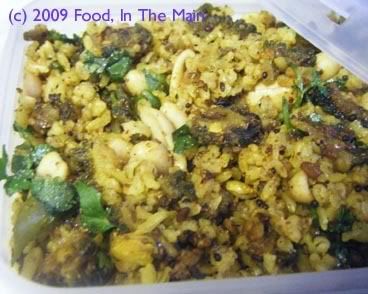
Ingredients
1-1/2 cups brown basmati rice, soaked in water for 10 minutes
3 cups bitter melon/karela, sliced
3/4 tsp tamarind paste
1/2 tsp turmeric powder
1 tsp urad dal 1 tsp brown mustard seeds
2 tsp oil
a few fresh curry leaves
3-4 tbsp garlic masala powder (or to taste)
Salt to taste
1/4 cup roasted salted peanuts
chopped coriander leaves for garnish
Method
1. Cook the soaked brown basmati rice in plenty of water to which 1 tsp turmeric powder has been added.
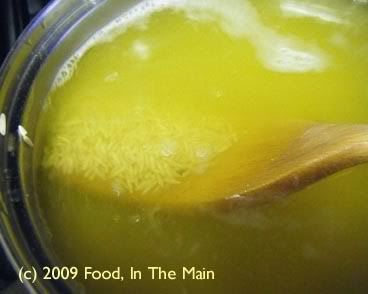
Drain rice and cool when cooked.
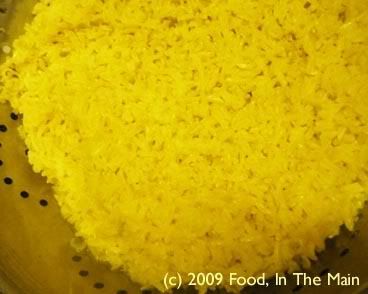
2. Dissolve the tamarind paste in 4 cups water and pour along with sliced karela in a saucepan. 
Cook the karela till done, but not mushy. Drain the cooked vegetable and reserve.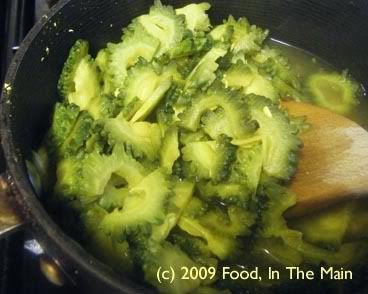
3. In a wide kadai or wok, heat the 2 tsp oil. Add the curry leaves, urad dal and mustard leaves. Cover till the mustard seeds pop, and the urad dal is golden brown. 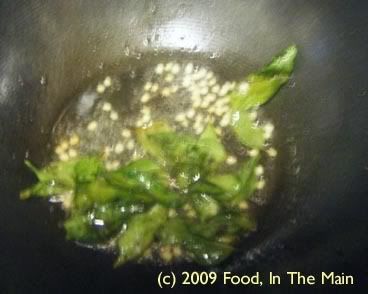
4. Add the cooked karela now and stir till the tempering is evenly distributed. 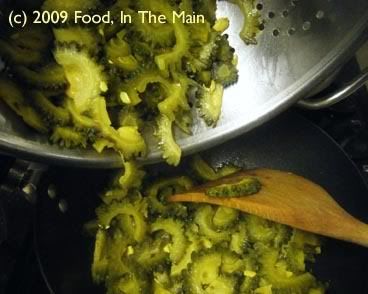
5. Sprinkle 2-3 tbsp of the garlic masala powder and stir it in. 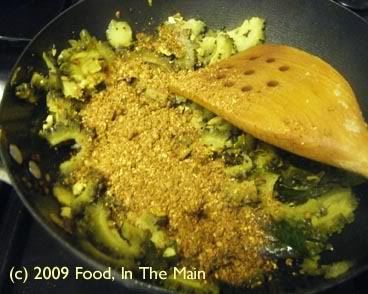
6. Roast the karela over medium heat in the pan, till it starts to crisp up. (You can add 2-3 tsp oil to speed up this process, if you like.)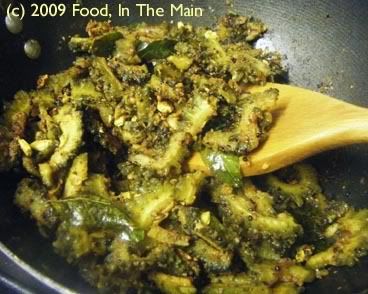
7. Add the cooked rice now, add salt to taste, and mix carefully till the vegetable is evenly distributed. 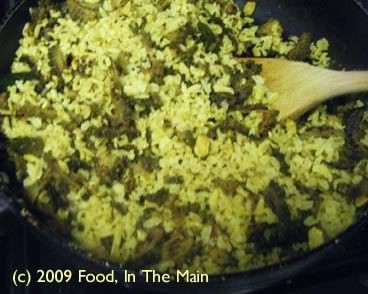
8. Stir-fry the rice till it's heated through, then add the peanuts and mix in. 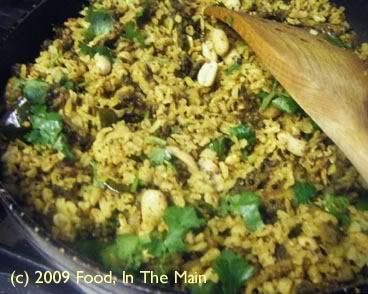 9. Sprinkle the chopped coriander over, and serve the rice hot with a cool cucumber raita and crisps or poppadums.
9. Sprinkle the chopped coriander over, and serve the rice hot with a cool cucumber raita and crisps or poppadums.
This is a recipe for grown-ups, because I cannot imagine any child ever liking something as bitter-tasting as karela or bittergourd - the name says it all. I would say that even for grown-ups, it is an acquired taste. It certainly was for me. It's only recently that I've felt like cooking karela... possibly because it's a reminder of India, and I cant get it locally - I dunno. Perhaps driving some 50-odd miles for vegetables makes me want to try even those that I'm not terribly fond of, just to justify the long trip!
I DO know that my mom hardly ever made karela at home because we kids simply would not touch it. I have to confess that even now, the only way I can eat it is if it's fried. Some of the bitterness lingers on the palate even then, but it's almost a pleasant sort of bitterness - if that can be imagined. Definitely an acquired taste.
And annoyingly, like most other unpleasant things, bittergourds are excellent for health - it's known for helping to lower blood sugar and high blood pressure, among other things. I guess the vegetable is mostly known in the Far East and India, the Caribbean and possibly parts of Africa. Bittergourds wouldnt carry off the first prize for good looks, either - the outer skin, ridged and knobbly, always reminds me of crocodile skin.
The bitterest part of the vegetable is the seeds inside. So unless the bittergourds are very young and tender, I would always recommend that the middle portion (containing the seeds) should be scraped out. Sprinkling the cut vegetable with salt and leaving it to sit for about an hour helps bring out the watery content, thereby reducing the bitterness some more.
I dont know how much of the goodness is lost in frying the bittergourd, but I figure that eating it fried will still be more beneficial than not eating it at all. Well, it makes sense to me...
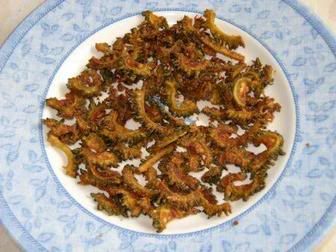
Recipe for: Karela (bittergourd) chips
Ingredients:
3-4 bittergourds
2 tsp salt
For the seasoning:
2 tbsp rice flour
2 tbsp gram flour
1 tsp red chilli powder (or more according to taste)
1 tsp coriander powder
1 tsp cumin powder
a pinch of asafoetida powder (optional)
Method:
1. Slice each piece of bittergourd into fairly thin half-moon shape. Transfer them to a colander and sprinkle the salt over. Shake the colander to distribute the salt evenly. Leave to rest for about an hour or so.
2. Squeeze out as much moisture as possible from the bittergourd pieces and dry them on paper towels. Transfer to a Ziploc bag or a big bowl.
3. Mix the seasoning ingredients together and sprinkle over the pieces. Shake the bag or bowl so that the seasoning is distributed evenly over the pieces.
4. Heat the oil in a wok, and fry the bittergourd pieces in batches to a crisp brown.
Serve as an accompaniment with Indian rice dishes, or eat as a snack.








































